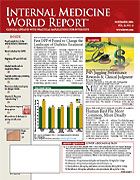Publication
Article
Internal Medicine World Report
Adding Warfarin to Aspirin Not Beneficial in PAD
Author(s):
From the World Congress of Cardiology Increases Severe Bleeding Risk
Barcelona—Adding anticoagulation to antiplatelet therapy does not reduce the incidence of major ischemic events in patients with peripheral artery disease (PAD) but does significantly increase the risk of bleeding, said Sonia Anand, MD, of McMaster University in Hamilton, Ontario, at the 15th World Congress of Cardiology.
“Oral anticoagulants added to antiplatelet therapy do not lower the rate of cardiovascular events and increase life-threatening bleedings compared to antiplatelet therapy alone in patients with PAD,” concluded Dr Anand.
She presented the results of the WAVE (Warfarin Antiplatelet Vascular Evaluation) study, conducted in 80 centers in 7 countries, in which 2161 patients with PAD were randomized to antiplatelet therapy with aspirin (81-325 mg/d) alone or to the combination of aspirin plus oral anticoagulation (warfarin).
To be eligible, patients had to have ≥1 “of the following: intermittent claudication with objective evidence of PAD (ankle-brachial index [ABI] <0.9), previous vascular reconstruction or angioplasty of a periphery artery, asymptomatic PAD (other vascular disease plus an ABI <0.9 or asymptomatic carotid stenosis >50%).
Therapy in the group receiving anticoagulation was titrated to achieve and maintain an international normalized ratio (INR) of 2.0 to 3.0. The mean INR achieved in the group was 2.2.
When the study began, patients’ mean age was 63.8 years, and mean ABI was 0.83. About one fourth (26.4%) were women. Follow-up ranged from 30 to 42 months.
P
On the first coprimary end point of the composite of cardiovascular (CV) disease/myocardial infarction (MI)/stroke, the combination therapy offered no significant advantage over aspirin alone (event rates, 12% vs 13.3%; = .49).
P
The second end point included severe ischemia in addition to CV disease, MI, and stroke. Some 15.9% randomized to combination therapy had this end point compared with 17.4% randomized to antiplatelet therapy alone, a nonsignificant ( = .38) 9% reduction.
Life-threatening bleeding was >3 times as common in the group receiving both oral anticoagulation and antiplatelet therapy (relative risk, 3.41; P <.001). There were 14 hemorrhagic strokes in patients assigned to the combination and none in those assigned to aspirin alone (P <.001). Moderate bleeding was also significantly more common in the combination group.
Freek W.A. Verheught, MD, of the Heartcenter, University Medical Center St. Radboud, in Nijmegen, the Netherlands, noted that 3 major trials in the post-MI population have shown that adding oral anticoagulation to aspirin therapy reduces CV death, reinfarction, and stroke compared with aspirin alone.
In WAVE, “explanation for failure to achieve benefit may be the play of chance or the low baseline risk of the patients compared to those in large post-MI trials,” he said.
He noted that adding clopidogrel (Plavix) to aspirin has not been shown to improve aspirin’s ability to reduce events in patients with PAD and that a direct comparison of oral anticoagulation alone and aspirin alone in peripheral vascular surgery showed no benefit over oral anticoagulation alone but did increase the risk of bleeding.
“Possibly, future antiplatelet agents and/or novel anticoagulants may protect patients with peripheral vascular disease better than aspirin,” Dr Verheught concluded.
Key points
• Patients with PAD have high rates of MI, stroke, and CV death, even when treated with antiplatelets.
• The WAVE trial showed that using aspirin + warfarin is no better at preventing CV events than aspirin alone.
• In addition, the combination regimen increased risk of lifethreatening bleeding by >3-fold.
For more information on the WAVE trial visit www.phri.ca/wave.





